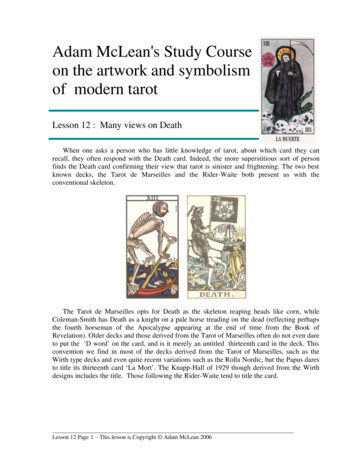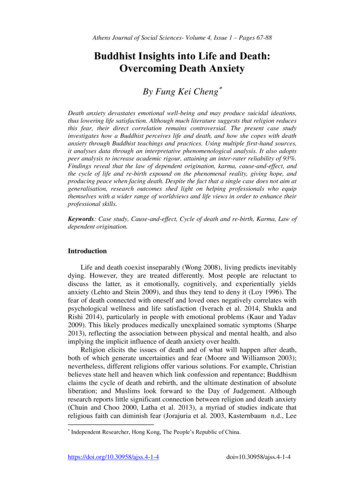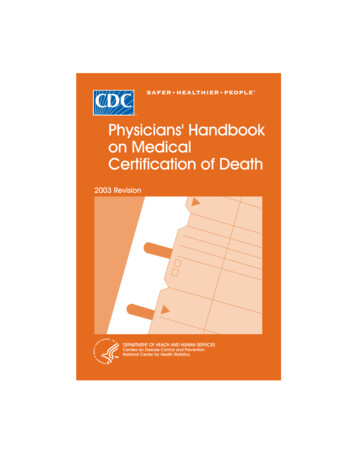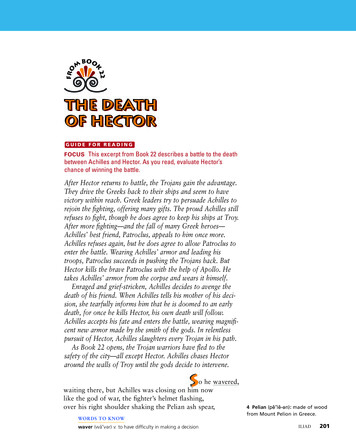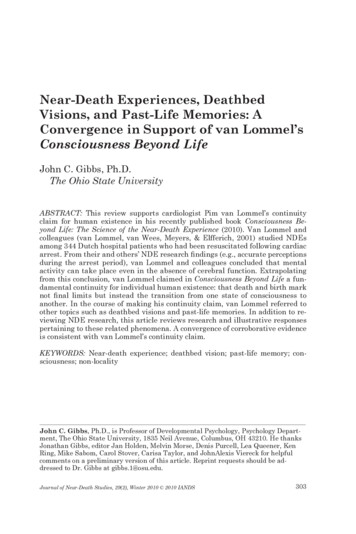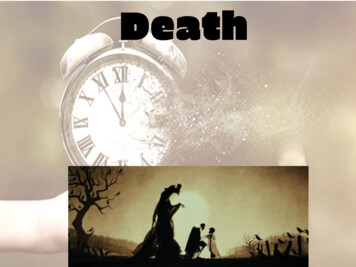
Transcription
Death
Importance of TOD 1st question at most murderscenes: "How long has thisperson been dead?“ It's crucial to know when thecrime was committed.– it can help narrow the searchfor a suspect or– it can help rule out potentialsuspects who had alibis at thetime the victim was killed.
Postmortem Time IntervalThe postmortem interval is the timesince death (how long has this personbeen dead?) What Time Did the Person Die?– Best estimate; offered with areasonable degree of medicaland scientific certainty.– Impossible to be 100% accurate.– UNLESS a witness (who doesn’tlie) is present at the time ofdeath, it generally is an estimateof time (2-4 hour window is theusual).
Estimating Time of Death1.2.3.4.5.6.7.8.9.Rigor mortisLivor mortis: (Lividity)Algor mortis: Body CoreTemperaturePotassium levels Clouding ofthe corneaStomach ContentsEvidence of DecompositionalProcessPresence/absence of purgefluidsDrying of the tissueInsect Larval Instars
Algor Mortis Uses body temperature todetermine time of death Normal body temperature is98.60F A body loses heat at a rate of1.40C per hour until the ambienttemperature is reached– Rate varies according toenvironmental temperature Once ambient temperature isreached, you cannot use thismethod to determine time ofdeath 24 hours
TOD Temp Calculations Normal body temperature is 98.60F Loss of body temperature at rate of 1.4 0F/hourfor the first 12 hours After the first 12 hours at a rate of 0.7 0F/hour
Factors affecting Algor MortisFactors affectingAlgor mortisEventEffectCircumstancesColdAccelerateLose heat fasterWarmSlowsLose heat slowerWindyAccelerateFaster heat lossCalmSlowsSlower heat lossObeseSlowsSlow down heat lossThinAccelerateSpeed up heat lossClothedSlowsSlow down heat lossNakedAccelerateSpeed up heat lossTemperatureWindBody fatClothing
Rigor mortis The medical condition that occurs after death Results in the shortening of muscle tissue and the stiffeningof body parts Body stays in the position they are in when death occurs Begins within 12 hours and ends after 48 hours: After 48 hours, muscle cells begin to autolyze
Rigor Mortis Timeline 1-4 hours: Jaw and neck rigid, restof body limp At 8 hours: everything down to thelegs is rigid At 12 hours: everything remainsrigid 24 hours: Jaw is limp, everythingelse is rigid 30-32 hours: everything but the legsare limp 36 hours: entire body is limp (norigidity) decomposition has begun
Rigor Mortis
Factors affecting Rigor MortisFactors affectingRigor mortisEventEffectCircumstancesWarmAccelerateSlower onsetColdSlowsFaster onsetAnaerobic ExerciseAccelerateBuildup of lactic acid and heat;accelerates rigorSleepSlowsFully oxygenated muscles slowdown rigorObeseSlowsFat stores oxygenThinAccelerateBody loses more oxygenTemperatureActivity Before DeathBody fat
Livor mortis Poolingor settling of blood in tissues after death Begins 2 hours after death becomes permanent after 8Livor mortis can Determine Time of Death Within 2-8 hours, can press skin and color disappears– Blanching Thumb pressure indicates that the lividity is not fully fixed Reveal the position of the corpse within first 8 hours If on back, blood will pool along backside Reveal if the body was moved
Blanching
Livor Mortis
Livor Mortis
Clouding of the Cornea Cornea is the clear covering of your eyes– Becomes cloudy and opaque after death Takes only 2 hours after death if eyes are open at death It takes 24 hours if eyes are closed at death
Stomach Contents Food flows from stomach to small intestine to largeintestine before leaving the body If there is undigested food in the stomach, death occurred0 to 2 hours after the meal If there is undigested food in the small intestine but notstomach, death occurred 4 to 6 hours after meal If there is food in the large intestine but not the smallintestine or stomach, death occurred 12 hours
Food Contents ExampleExample –Determine the time ofdeath from the lastmeal if food is foundin the small intestineAnswer: Death occurred4 - 6 hours after the lastmeal
Summary of FactorsPROMOTING DECAYDELAYING DECAYOxygen supply not restrictedOxygen supply restrictedWarm temperature (15-37 C)Cold temperature ( 10 C; decay will cease below 0 C)Humid atmosphereDry atmospherePresence of invertebrate detritivores (e.g. blowfly larvae)Absence of invertebrate detritivoresWasp, ant and other invertebrate predators feeding on corpseWasp, ant and other invertebrate predator feeding on detritivoresWounds permitting invertebrates easier access to internal bodytissuesInability of detritivores to gain access to all or part of the corpseSurface burning causing skin to crack and thereby allowing easieraccess of invertebrates and oxygen to internal tissuesIntense burning resulting in tissues becoming carbonized and dryingout.ObesityBurial on land or underwater (rate of decay declines with increasingdepth)Suffering from septicemia or myiasis before deathBody suspended above ground (e.g. hanging)Body exposed to the environment above groundFormation of adipocereMummificationBody resting on soilEmbalming
Uses body temperature to determine time of death Normal body temperature is 98.60F A body loses heat at a rate of 1.40C per hour until the ambient temperature is reached –Rate varies according to environmental temperature Once ambient temperature is reached, you ca

